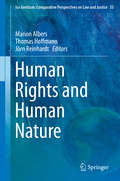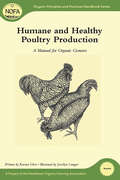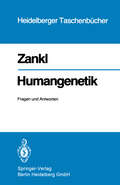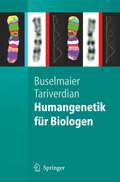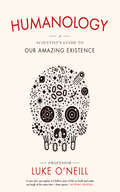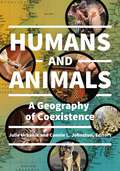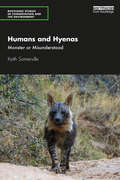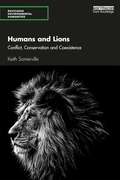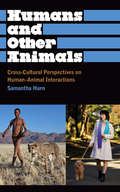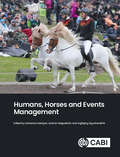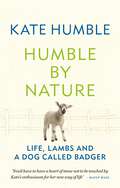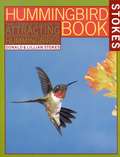- Table View
- List View
Human Origins and Environmental Backgrounds (Developments in Primatology: Progress and Prospects)
by Masato Nakatsukasa Hidemi Ishida Russell Tuttle Martin Pickford Naomichi OgiharaAdvances in fossil studies relating to the origin of Homo sapiens have strengthened the hypothesis that our direct ancestors originated on the African continent. Most researchers also agree that the time when prehumans diverged from the last common ancestor was in the early part of the Late Miocene epoch. Focus must now shift from determining the times and places of hominid origins to clarifying hominid evolutionary problems, such as the selective factors and acquisition processes of hominid bipedalism. In March of 2003, researchers from Africa, Europe, Japan and the United States convened in Kyoto for a symposium on Human Origins and Environmental Backgrounds, an interdisciplinary effort to consider these evolutionary puzzles, to report current research and to exchange thoughts towards better understanding the relationship among environmental changes, adaptive mechanisms and human origins. This book is the result of that symposium, and includes a diverse and unique set of papers on topics such as hominid evolution, dispersal and morphology, and the origins of bipedalism.
Human Parasites: Diagnosis, Treatment, Prevention
by Heinz MehlhornThis textbook provides an up-to-date overview of the most important parasites in humans and their potential vectors. For each parasite, the book offers a concise summary including its distribution, epidemiology, life cycle, morphology, clinical manifestations, diagnosis, prophylaxis and therapeutic measures. Numerous tables, diagrams and over 200 colorful illustrations highlight the main aspects of parasitic infestations and present suitable control measures. 60 questions help to test readers’ theoretical knowledge of the field. In short, the book is highly recommended for anyone looking to delve into the field of human parasitology. It is intended for students of biology and human medicine, medical doctors, pharmacists and laboratory staff alike. Furthermore, persons who plan to visit or live longer in endemic regions will find essential information on necessary preventive and control measurements.
Human Parasites: Diagnosis, Treatment, Prevention
by Heinz MehlhornThe new edition of this textbook provides an up-to-date overview of the most important parasites in humans and their potential vectors. Climate change and globalization steadily favor the opportunities for parasites to thrive. These challenges call for the latest information on pathogen transmission routes and timely preventive measures.For each parasite, this book offers a concise summary in eleven sections:1. Naming2. Geographic distribution and epidemiology3. Morphology, biology and life cycle4. Disease symptoms5. Diagnosis6. Infection pathways7. Prophylaxis8. Incubation period9. Prepatency10. Patency11. Therapeutic optionsNumerous tables, diagrams and over 200 colorful illustrations highlight the main aspects of parasitic infestations and present suitable control measures. Moreover, 60 questions help to test readers’ theoretical knowledge of the field. Readers can additionally download the free Springer Nature Flashcards App and benefit from the digital study questions.In short, this work is highly recommended for anyone looking to delve into the field of human parasitology. It is intended for students of biology and human medicine, medical doctors, pharmacists and laboratory staff alike. Furthermore, persons who plan to visit or live longer in endemic regions will find essential information on necessary preventive and control measurements.
Human Rights and Human Nature (Ius Gentium: Comparative Perspectives on Law and Justice #35)
by Marion Albers Thomas Hoffmann Jörn ReinhardtThis book explores both the possibilities and limits of arguments from human nature in the context of human rights. Can the concept of human nature provide a basis for understanding fundamental rights? Is it plausible to justify the claim to universal validity of human rights by reference to human nature? Or does the idea of human rights in its modern, post-1945 manifestation go, in essence, beyond human nature? The essays in this volume introduce naturalistic positions and their concomitant critiques. They address the role that human nature both actually does and potentially may play in forming a foundation for and acting as an exemplification of fundamental rights. Beyond that, they give attention to the challenges caused by Life Sciences. Human nature itself is subject to transformation and transgression in an unprecedented manner. The essays reflect on issues such as reproduction, species manipulation, corporeal autonomy and enhancement. Contributors are jurists, philosophers and political scientists from Germany, Switzerland, Turkey, Poland and Japan.
Human System Responses to Disaster: An Inventory of Sociological Findings (Springer Series on Environmental Management)
by Thomas E. DrabekThis series is dedicated to serving the growing community of scholars and practitioners concerned with the principles and applications of environ mental management. Each volume is a thorough treatment of a specific topic of importance for proper management practices. A fundamental ob jective of these books is to help the reader discern and implement man's stewardship of our environment and the world's renewable resources. For we must strive to understand the relationship between man and nature, act to bring harmony to it, and nurture an environment that is both stable and productive. These objectives have often eluded us because the pursuit of other in dividual and societal goals has diverted us from a course of living in balance with the environment. At times, therefore, the environmental manager may have to exert restrictive control, which is usually best applied to man, not nature. Attempts to alter or harness nature have often failed or backfired, as exemplified by the results of imprudent use of herbicides, fertilizers, water, and other agents. Each book in this series will shed light on the fundamental and applied aspects of environmental management. It is hoped that each will help solve a practical and serious environmental problem. Robert S. DeSanto East Lyme, Connecticut Acknowledgments Compilation of the materials reviewed in this inventory was facilitated greatly by several staff members of the Disaster Research Center, University of Delaware (formerly at The Ohio State University) and the Natural Haz ards Research and Applications Information Center, University of Colorado.
Human-Wildlife Interactions: From Conflict to Coexistence
by Michael R. Conover Denise O. ConoverThis book won the 2023 The Wildlife Society Publication Award in the authored book category. Human-wildlife interactions increase exponentially as more and more humans and wildlife crowd into the same limited space. Such interactions often become conflicts when wildlife threaten human health and safety, well-being, or the food supply. This second edition of Human-Wildlife Interactions: From Conflict to Coexistence provides a comprehensive review of the severity of these problems and the methods used to resolve clashes between humans and wildlife. During his forty-year career as a wildlife professor and scientist, Dr. Michael Conover, founder of journal Human-Wildlife Interactions, has become a recognized leader of the scientific field of human-wildlife interactions. In this book, he presents the range of methods for wildlife damage management, including employing lethal methods; distributing supplemental food; changing the behavior of either humans or wildlife; and excluding or repelling wildlife. Backed by numerous case studies and informative side bars, the book documents resolutions to specific human-wildlife conflicts throughout the literature. Containing full color illustrations throughout, the second edition of Human-Wildlife Interactions: From Conflict to Coexistence provides authoritative coverage and depth of both theoretical and practical information. It serves as an invaluable resource for students, researchers, and professional wildlife managers. Disclaimer: Figure 7.7 (b) on page 251 was incorrectly attributed in previous printings. The photographer of figure 7.7 (b) is Cynthia Herrick.
Human-Wildlife Interactions: From Conflict to Coexistence
by Michael R. Conover Denise O. ConoverThis book won the 2023 The Wildlife Society Publication Award in the authored book category. Human-wildlife interactions increase exponentially as more and more humans and wildlife crowd into the same limited space. Such interactions often become conflicts when wildlife threaten human health and safety, well-being, or the food supply. This second edition of Human-Wildlife Interactions: From Conflict to Coexistence provides a comprehensive review of the severity of these problems and the methods used to resolve clashes between humans and wildlife. During his forty-year career as a wildlife professor and scientist, Dr. Michael Conover, founder of journal Human-Wildlife Interactions, has become a recognized leader of the scientific field of human-wildlife interactions. In this book, he presents the range of methods for wildlife damage management, including employing lethal methods; distributing supplemental food; changing the behavior of either humans or wildlife; and excluding or repelling wildlife. Backed by numerous case studies and informative side bars, the book documents resolutions to specific human-wildlife conflicts throughout the literature. Containing full color illustrations throughout, the second edition of Human-Wildlife Interactions: From Conflict to Coexistence provides authoritative coverage and depth of both theoretical and practical information. It serves as an invaluable resource for students, researchers, and professional wildlife managers. Disclaimer: Figure 7.7 (b) on page 251 was incorrectly attributed in previous printings. The photographer of figure 7.7 (b) is Cynthia Herrick.
The Human Zoo: A Zoologist's Study Of The Urban Animal
by Desmond MorrisThis study concerns the city dweller. Morris finds remarkable similarities with captive zoo animals and looks closely at the aggressive, sexual and parental behaviour of the human species under the stresses and pressures of urban living.
Humanbiologie für Lehramtsstudierende: Ein Arbeits- und Studienbuch
by Armin BaurDieses Buch bietet dem Leser die Möglichkeit, sich nach eigenem Interesse und nach Studienrichtung (Lehramt für Primarstufe, Sekundarstufe I, Sekundarstufe II) mit differenzierten Inhalten, Anregungen und Hilfestellungen, die individuelles Lernen ermöglichen, in die Humanbiologie einzuarbeiten. Hierzu sind die Themen der Humanbiologie, welche später für die Schule relevant sind, kurz und knapp dargestellt. Das Buch enthält Aufgaben und Abbildungen zum Beschriften (jeweils mit Lösungen). Über die Verlagsinternetseite werden Zusatzübungen, Filme und Anleitungen zum Bau von Modellen zur Verdeutlichung von Inhalten bereitgestellt.Aus dem Inhalt:- Zelle und Gewebe- Atmung- Herz, Kreislauf, Blut und Lymphe- Bewegung- Sinnesorgane (Auge, Ohr, Haut)- Nervensystem- Hormonsystem- Ernährung und Verdauung - Wasser-Elektrolyt-Haushalt - Fortpflanzung und EntwicklungDas Buch wurde für Lehramtsstudierende Biologie geschrieben, eignet sich aber auch für andere Biologiestudierende und Leser, die einen Einblick in das Thema bekommen möchten.Über den AutorDr. Armin Baur lehrt momentan Humanbiologie an der PH Schwäbisch Gmünd. Bei der Erstellung des Buches hat er seine früheren Erfahrungen aus dem Studium, aus seiner Tätigkeit als Lehrer und Ausbildungslehrer und aus seiner derzeitigen Lehrtätigkeit an der Hochschule einfließen lassen.
Humanbiologie kompakt
by Wolfgang Clauss Cornelia ClaussDie Grundlagen der Humanbiologie – kompakt, verständlich, lernbarDieses für den Einstieg konzipierte Buch präsentiert in konzentrierter Form die Grundzüge der Biologie des Menschen – ideal für Studierende der Biowissenschaften und der Medizin, die einen kompakten Überblick über dieses weite Feld benötigen. Das Kernwissen zur Physiologie, Anatomie, Genetik und Evolution des Menschen ist in kurzen Kapiteln verständlich zusammengefasst und mit klaren Grafiken anschaulich gemacht. Lernziele und Merksätze unterstützen die Aneignung des Wissens, Übungsfragen am Ende jedes Kapitels erlauben eine Überprüfung des Gelernten und bereiten auf Klausuren und Prüfungen vor.Der dargebotene Stoff ist auf Lehrveranstaltungen von (Bachelor-)Studiengängen zahlreicher deutschsprachiger Universitäten zugeschnitten. Wer ein Studienmodul „Humanbiologie" durchläuft, als zukünftiger Lehrer die biologische Seite des Themas „Mensch" kurz und bündig erfassen möchte oder im Medizinstudium die humanbiologischen Grundlagen der Molekularen Medizin verstehen will, ist mit diesem Buch, das nun in einer ergänzten Neuauflage vorliegt, bestens bedient. Hintergrundinformation: Die Humanbiologie gehört als (interdisziplinäre) naturwissenschaftliche Disziplin sowohl zu den Bio- als auch zu den Humanwissenschaften. Sie befasst sich zum einen mit der Biologie des Menschen, zum anderen mit den biologischen Grundlagen der Humanmedizin. Ein besonderes Gewicht hat sie auch für den Lehramtsbereich (Ausbildung für Gymnasien / Pädagogische Hochschulen). War die Humanbiologie früher eher an der klassischen Anthropologie ausgerichtet, so haben sich mit Einzug der molekularen Wissenschaften die Inhalte mehr in Richtung einer auf den Menschen angewandten molekularen Biowissenschaft gewandelt, die sich mit der Erklärung, Prävention und Therapie von Krankheitsursachen befasst. Ein Blick auf die im deutschsprachigen Raum angebotenen neuen Studiengänge zeigt einen regelrechten Boom in diesem Sektor (neben "Humanbiologie" treten dabei verstärkt auch Bezeichnungen wie Molekulare Medizin, Bio-Medizin, Molekulare Biomedizin, Molecular Life Science o. Ä. auf). In zahlreichen (Bachelor-)Studiengängen der Biowissenschaften wird die (moderne) Humanbiologie als eigenständiges Modul angeboten. Zudem finden sich solche Module auch in Studiengängen der Medizintechnik, der Gesundheitsbildung, des Wissenschaftsjournalismus etc. Eine starke Verankerung hat die Humanbiologie schließlich an Pädagogischen Hochschulen, wo sie zum Teil in sehr moderne und umfangreiche Programme und Studienangebote eingebunden ist.
Humane and Healthy Poultry Production: A Manual for Organic Growers (Organic Principles and Practices Handbook Series)
by Karma Glos Jocelyn LangerPart of the NOFA guides. Includes information on: Organic poultry basics Establishing the facilities (housing and equipment, choosing and using litter, outdoor access, brooding, grazing and pasturing) Purchasing and brooding chicks Organic feed and supplements Poultry health care in the organic system Management challenges (production and culling, spotted shells, yolk color) Slaughter and Processing Marketing Production expectations and economic viability
Humangenetik: Fragen und Antworten (Heidelberger Taschenbücher #207)
by Heinrich ZanklDie Humangenetik gehört zu den "kleinen Fächern", denen die Medizinstudenten bei ihrer Vorbereitung auf den 1. Abschnitt der ärztlichen Prüfung bisher nur wenig Beachtung geschenkt haben. Durch die Verschärfung der Prüfungsbedingungen ist es jedoch not wendig geworden, sich auch auf dieses Fach intensiv vorzubereiten. Da es nicht möglich ist, kurz vor der Prüfung ganze Lehrbücher durchzuarbeiten, erschien es sinnvoll, einen Text zur Verfügung zu stellen, der ohne großen Zeitaufwand mit den für die Prüfung wichtigsten Themen vertraut macht. Das vorliegende Büchlein ist aus einem Seminar für Prüfungskandidaten hervorgegangen, das sich bei den Studenten großer Beliebtheit erfreut. Durch die Orientierung des Textes an einzelnen Fragen hat der Student Gelegenheit, die Prüfungssituation zu simulieren und sein Wissen zu kontrollieren. Die Antworten wurden so umfassend gestaltet, daß klar wird, warum eine bestimmte Antwort richtig ist und daß auch andere Fragen zum gleichen Themenkreis beantwortet werden können. Soweit notwen dig, wurde auch auf Unklarheiten und bewußte Fallen in der Fragestellung hingewiesen, um den Blick der Studenten für solche Prüfungserschwernisse zu schärfen.
Humangenetik für Biologen (Springer-Lehrbuch)
by Werner Buselmaier Gholamali TariverdianIm Zentrum dieses Lehrbuchs steht die moderne molekularbiologische Entwicklung. Sie besitzt das innovativste Potential innerhalb aller Forschungsgebiete. Neben verschiedenen methodischen Ansätzen präsentieren die Autoren die Ergebnisse des Human Genom Projekts, welches man wohl als das ehrgeizigste Wissenschaftsprojekt der Menschheitsgeschichte bezeichnen kann.
Humanology: A Scientist's Guide to Our Amazing Existence
by Professor Luke O'NeillDiscover the answers to 20 burning questions about life and our amazing existence with Ireland’s most exciting scientist, Professor Luke O’Neill.Taking us on an incredible journey across centuries and galaxies, accompanied by his characteristic wit, Professor Luke O’Neill explains how it all began, how it all will end and everything in between. Readers will benefit from Luke’s insatiable curiosity for life when they dive into this ultimate journey through life and death.Among many fascinating facts, you’ll discover the science behind how we got to be so smart, why sex with a caveman was a good idea, the science of finding love, why we follow religions, and how robots will become part of everyday life. Humanology is a humbling reminder that we’re just a small speck in a big universe – so sit back and embrace the adventure.‘A man who can explain 4.2 billion years of life on Earth and make me laugh at the same time – sheer genius.’ Pat Kenny, Newstalk
Humans and Animals: A Geography of Coexistence
by Julie Urbanik and Connie L. Johnston, EditorsAn engaging and at times sobering look at the coexistence of humans and animals in the 21st century and how their sometimes disparate needs affect environments, politics, economies, and culture worldwide.There is an urgent need to understand human-animal interactions and relations as we become increasingly aware of our devastating impact on the natural resources needed for the survival of all animal species. This timely reference explores such topics as climate change and biodiversity, the impact of animal domestication and industrial farming on local and global ecosystems, and the impact of human consumption of wild species for food, entertainment, medicine, and social status. This volume also explores the role of pets in our lives, advocacy movements on behalf of animals, and the role of animals in art and media culture. Authors Julie Urbanik and Connie L. Johnston introduce the concept of animal geography, present different aspects of human-animal relationships worldwide, and highlight the importance of examining these interconnections. Alphabetical entries illustrate key relationships, concepts, practices, and animal species. The book concludes with a comprehensive appendix of select excerpts from key primary source documents relating to animals and a glossary.
Humans and Animals: A Geography of Coexistence
by Julie Urbanik Connie L. JohnstonAn engaging and at times sobering look at the coexistence of humans and animals in the 21st century and how their sometimes disparate needs affect environments, politics, economies, and culture worldwide.There is an urgent need to understand human-animal interactions and relations as we become increasingly aware of our devastating impact on the natural resources needed for the survival of all animal species. This timely reference explores such topics as climate change and biodiversity, the impact of animal domestication and industrial farming on local and global ecosystems, and the impact of human consumption of wild species for food, entertainment, medicine, and social status. This volume also explores the role of pets in our lives, advocacy movements on behalf of animals, and the role of animals in art and media culture. Authors Julie Urbanik and Connie L. Johnston introduce the concept of animal geography, present different aspects of human-animal relationships worldwide, and highlight the importance of examining these interconnections. Alphabetical entries illustrate key relationships, concepts, practices, and animal species. The book concludes with a comprehensive appendix of select excerpts from key primary source documents relating to animals and a glossary.
Humans and Hyenas: Monster or Misunderstood (Routledge Studies in Conservation and the Environment)
by Keith SomervilleHumans and Hyenas examines the origins and development of the relationship between the two to present an accurate and realistic picture of the hyena and its interactions with people. The hyena is one of the most maligned, misrepresented and defamed mammals. It is still, despite decades of research-led knowledge, seen as a skulking, cowardly scavenger rather than a successful hunter with complex family and communal systems. Hyenas are portrayed as sex-shifting deviants, grave robbers and attackers of children in everything from African folk tales through Greek and Roman accounts of animal life, to Disney’s The Lion King depicting hyenas with a lack of respect and disgust, despite the reality of their behaviour and social structures. Combining the personal, in-depth mining of scientific papers about the three main species and historical accounts, Keith Somerville delves into our relationship with hyenas from the earliest records from millennia ago, through the accounts by colonisers, to contemporary coexistence, where hyenas and humans are forced into ever closer proximity due to shrinking habitats and loss of prey. Are hyenas fated to retain their bad image or can their amazing ability to adapt to humans more successfully than lions and other predators lead to a shift in perspective? This book will be of great interest to students and scholars in the environmental sciences, conservation biology, and wildlife and conservation issues.
Humans and Hyenas: Monster or Misunderstood (Routledge Studies in Conservation and the Environment)
by Keith SomervilleHumans and Hyenas examines the origins and development of the relationship between the two to present an accurate and realistic picture of the hyena and its interactions with people. The hyena is one of the most maligned, misrepresented and defamed mammals. It is still, despite decades of research-led knowledge, seen as a skulking, cowardly scavenger rather than a successful hunter with complex family and communal systems. Hyenas are portrayed as sex-shifting deviants, grave robbers and attackers of children in everything from African folk tales through Greek and Roman accounts of animal life, to Disney’s The Lion King depicting hyenas with a lack of respect and disgust, despite the reality of their behaviour and social structures. Combining the personal, in-depth mining of scientific papers about the three main species and historical accounts, Keith Somerville delves into our relationship with hyenas from the earliest records from millennia ago, through the accounts by colonisers, to contemporary coexistence, where hyenas and humans are forced into ever closer proximity due to shrinking habitats and loss of prey. Are hyenas fated to retain their bad image or can their amazing ability to adapt to humans more successfully than lions and other predators lead to a shift in perspective? This book will be of great interest to students and scholars in the environmental sciences, conservation biology, and wildlife and conservation issues.
Humans and Lions: Conflict, Conservation and Coexistence (Routledge Environmental Humanities)
by Keith SomervilleThis book places lion conservation and the relationship between people and lions both in historical context and in the context of the contemporary politics of conservation in Africa. The killing of Cecil the Lion in July 2015 brought such issues to the public’s attention. Were lions threatened in the wild and what was the best form of conservation? How best can lions be saved from extinction in the wild in Africa amid rural poverty, precarious livelihoods for local communities and an expanding human population? This book traces man’s relationship with lions through history, from hominids, to the Romans, through colonial occupation and independence, to the present day. It concludes with an examination of the current crisis of conservation and the conflict between Western animal welfare concepts and sustainable development, thrown into sharp focus by the killing of Cecil the lion. Through this historical account, Keith Somerville provides a coherent, evidence-based assessment of current human-lion relations, providing context to the present situation. This book will be of interest to students and scholars of environmental and African history, wildlife conservation, environmental management and political ecology, as well as the general reader.
Humans and Lions: Conflict, Conservation and Coexistence (Routledge Environmental Humanities)
by Keith SomervilleThis book places lion conservation and the relationship between people and lions both in historical context and in the context of the contemporary politics of conservation in Africa. The killing of Cecil the Lion in July 2015 brought such issues to the public’s attention. Were lions threatened in the wild and what was the best form of conservation? How best can lions be saved from extinction in the wild in Africa amid rural poverty, precarious livelihoods for local communities and an expanding human population? This book traces man’s relationship with lions through history, from hominids, to the Romans, through colonial occupation and independence, to the present day. It concludes with an examination of the current crisis of conservation and the conflict between Western animal welfare concepts and sustainable development, thrown into sharp focus by the killing of Cecil the lion. Through this historical account, Keith Somerville provides a coherent, evidence-based assessment of current human-lion relations, providing context to the present situation. This book will be of interest to students and scholars of environmental and African history, wildlife conservation, environmental management and political ecology, as well as the general reader.
Humans and Other Animals: Cross-Cultural Perspectives on Human-Animal Interactions (Anthropology, Culture and Society)
by Samantha HurnWhat are our attitudes towards other animals, and how does this affect our humanity? *BR**BR*This work of anthrozoology explores the myriad and evolving ways in which humans and animals interact, the divergent cultural constructions of humanity and animality found around the world, and individual experiences of other animals. *BR**BR*This book looks at case studies covering blood sports (such as hunting, fishing and bull fighting), pet keeping and ‘petishism’, eco-tourism and wildlife conservation, working animals and animals as food. It addresses the idea of animal exploitation raised by the animal rights movements, as well as the anthropological implications of changing attitudes towards animal personhood, and the rise of a posthumanist philosophy in the social sciences more generally.
Humans and Other Animals: Cross-Cultural Perspectives on Human-Animal Interactions (Anthropology, Culture and Society)
by Samantha HurnWhat are our attitudes towards other animals, and how does this affect our humanity? *BR**BR*This work of anthrozoology explores the myriad and evolving ways in which humans and animals interact, the divergent cultural constructions of humanity and animality found around the world, and individual experiences of other animals. *BR**BR*This book looks at case studies covering blood sports (such as hunting, fishing and bull fighting), pet keeping and ‘petishism’, eco-tourism and wildlife conservation, working animals and animals as food. It addresses the idea of animal exploitation raised by the animal rights movements, as well as the anthropological implications of changing attitudes towards animal personhood, and the rise of a posthumanist philosophy in the social sciences more generally.
Humans, Horses and Events Management
by Katherine Dashper Guðrún Helgadóttir Ingibjörg SigurðardóttirHorses are perhaps the most common non-human animal to feature in planned events, but although there is considerable research on equestrian sport, there is virtually none on equestrian events. This book begins to address this gap, using the National Championships of the Icelandic Horse as an extended case study to explain in depth the process of managing an event, as well as the larger theoretical implications of events management. Drawing on diverse viewpoints and theoretical perspectives, the book draws wider comparisons to connect events management to larger themes in the social sciences, such as human-animal relations; nationalism; place branding; event impacts; event experience; and inclusion and exclusion. The book is a contribution to two fields. In relation to human-animal studies, it focuses on how the Icelandic horse breed is marketed and celebrated through top-tier competition; whereas from an events management perspective, it considers the role of the event in community building, the practical and theoretical aspects of running a sustainable equestrian event, and the issues that arise in multispecies event contexts. This book: - Uniquely draws together events management and human-animal studies. - Is formed from empirical research conducted by a multinational team of events management and tourism researchers. - Uses a single, extended case study to explore a range of themes and issues, both empirically and theoretically. A valuable resource for researchers of events management, human-animal studies and tourism, this book also provides an in-depth look at end-to-end events management for industry professionals.
Humble by Nature: Life, lambs and a dog called Badger (Kate Humble)
by Kate Humble'You'd have to have a heart of stone not to be touched by Kate's enthusiasm for her new way of life' - Daily MailIn 2007, after 20 years of living in London, Kate Humble and her husband Ludo decided it was time to leave city life behind them. Three years later, now the owner of a Welsh smallholding, Kate hears that a nearby farm is to be broken up and sold off. Another farm lost; another opportunity for a young farmless farmer gone. Desperate to stop the sale, Kate contacts the council with an alternative plan - to keep the farm working and to run a rural skills and animal husbandry school alongside it. Against all odds, she succeeds.Here, in Humble by Nature, Kate shares with us a highly personal account of her journey from London town house to Welsh farm. Along the way we meet Bertie and Lawrence the donkeys, Myfanwy and Blackberry the pigs and goats Biscuit and Honey, not forgetting a dog called Badger and his unladylike sidekick Bella. And we are introduced to the tenant farmers Tim and Sarah, the locals who helped and some who didn't, and a whole host of newborn lambs.Full of the warmth and passion for the natural world that makes Kate such a sought after presenter, Humble By Nature is the story of two people prepared to follow their hearts and save a small part of Britain's farming heritage, whatever the consequences.
The Hummingbird Book: The Complete Guide to Attracting, Identifying,and Enjoying Hummingbirds
by Donald Stokes Lillian StokesAttract amazing hummingbirds to your backyard! With this comprehensive, beautifully illustrated guide, you'll find it easy to attract these tiny jewel-like birds to your own yard. With this comprehensive, beautifully illustrated guide, you'll find it easy to attract these tiny, jewel-like birds to your own yard. The Stokes Hummingbird Book provides all the information you need to bring hummingbirds up close, identify them, and understand their fascinating and varied behavior. The book includes:Range maps and full-color photographs to help you identify and locate hummingbirdsInformation on how to select the proper feeders, what to use in them, when to put them up, and when to take them downAdvice on what flowers to plant to attract hummingbirds in your part of the countryAmazing facts about hummingbirds, such as how fast they fly and how much they weighGuidelines for photographing hummingbirdsComplete information on hummingbird behavior, including flight displays, breeding habits, and feedingA special section on attracting orioles, with photographs and behavior guides for each of the eight species found in North AmericaA resource list for hummingbird supplies



